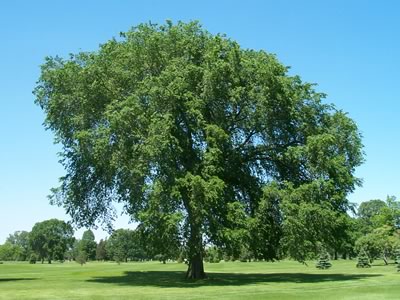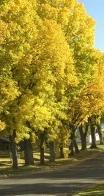Elm Tree
 Elm trees are large and grand shade trees. Elm trees grow well even in the
most severe urban situations. The elm tree transplants
easily and grows rapidly if conditions are favorable. Healthy elm tree
leaves are lustrous dark green in the summer and turning yellow in the fall.
Elm trees are large and grand shade trees. Elm trees grow well even in the
most severe urban situations. The elm tree transplants
easily and grows rapidly if conditions are favorable. Healthy elm tree
leaves are lustrous dark green in the summer and turning yellow in the fall.
Elm trees grow best in full sun but are tolerant to moderate shade too. They have a great tolerance to soil pH, growing well in the range of 5.5 to 8.0. They are also tolerant of compacted clay soils, well drained sandy soils and most soils in between. They grow best in nutrient rich, moist well drained soils.
Buy elm tree seeds, click-below for information ....
CLICK-HERE to order Elm Tree Seeds - Only $5.00 elm tree seeds for sale - FREE Planting Guide included
Elm Tree Disease
 Dutch elm disease (DED), is the most widely-known elm tree disease, which affects elm trees world-wide. Dutch elm disease is a fungal disease of elm trees
which is spread by the elm bark beetle.
Dutch elm disease (DED), is the most widely-known elm tree disease, which affects elm trees world-wide. Dutch elm disease is a fungal disease of elm trees
which is spread by the elm bark beetle.
The most common and well know disease is Dutch elm disease (DED). This is a fungal disease which is transmitted by twig or trunk feeding beetles and root grafts. Dutch elm disease plugs the vascular system of the tree causing a wilt which is often seen first in the upper branches (flags) and may move throughout the entire tree within a year. Elm yellows is another serious disease of elms which causes yellowing, thinning, premature leaf drop and eventually death of infected trees. When leaves appear white during the summer the cause is a powdery mildew fungus. Black spots and premature defoliation are caused by another fungus. Scorching or yellowing of the leaf margins is caused by a bacterial infection of the woody tissue. Symptoms are often confused with DED, however, bacterial leaf scorch symptoms are seen in late summer and the leaves drop rather than die and hang onto branches.
The search for DED resistant elms has been a slow process and complicated by a number of factors. However, much research has been completed and DED resistant elm trees have been developed. It is a good idea to keep in mind that all trees are subject to problems of one type or another. Although resistant elm trees have been developed, it is important to remember that they are not immune. However, resistance combined with proper care ensures the best chance for success growing elm trees.
Elm Tree Varieties
- American Elm - Ulmus Americana
- Chinese Elm, Lacebark Elm - Ulmus Parvifolia
- Japanese Zelkova - Zelkova Serrata
- Rock Elm - Ulmus Thomasii
- Siberian Elm - Ulmus Pumila
- Slippery Elm - Ulmus Rubra
The most important factor for healthy elm trees is good soil. The type of soil determines not only how much nutrients and water the elm tree has access to, but also how efficiently the elm tree can use those nutrients. These factors will determine whether your elm tree can successfully withstand the stresses of growing in an urban environment or fight diseases such as Dutch elm disease.
As a homeowner, the best contribution you can make to your elm tree's soil and to the long-term viability of your tree is the addition of beneficial mycorrhizal fungi.
Elm Tree Facts
Elm Seed Germination - Under natural conditions, elm seeds that ripen in the spring usually germinate in the same growing season. Elm Tree seeds that ripen in the fall will germinate in the following spring. Although seeds of most elm species require no planting treatment, American elm will remain dormant until the second season
The native range of the American elm tree is found throughout Eastern North America. Its range is from Cape Breton Island, Nova Scotia, west to central Ontario, southern Manitoba, and southeastern Saskatchewan; south to extreme eastern Montana, northeastern Wyoming, western Nebraska, Kansas, and Oklahoma into central Texas; east to central Florida; and north along the entire east coast.
Elm Trees add beauty and value to your property.
Fully mature elm trees can live as long as 300-years. The American Elm tree grows to over 115-feet tall and can have a diameter in excess of 10-feet.




